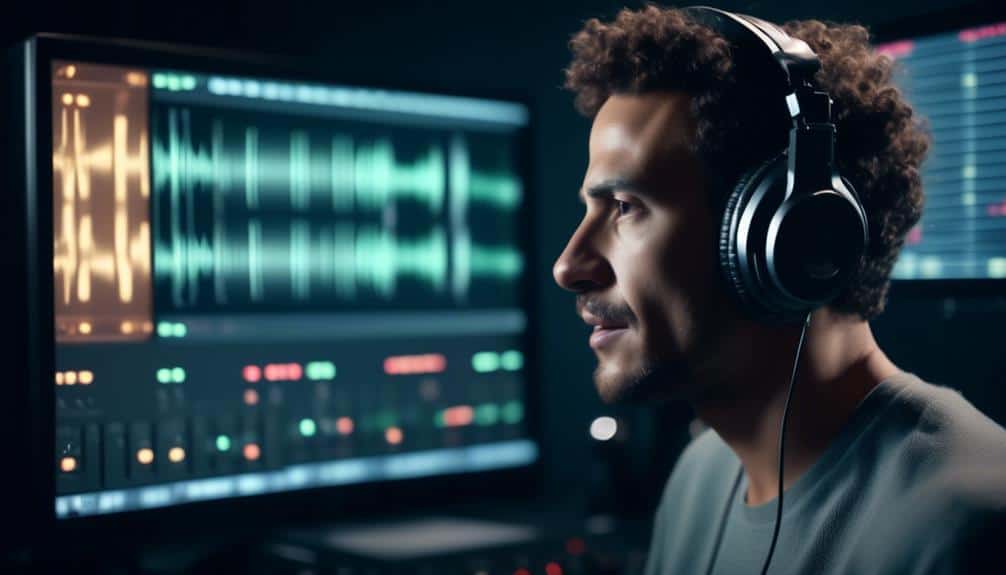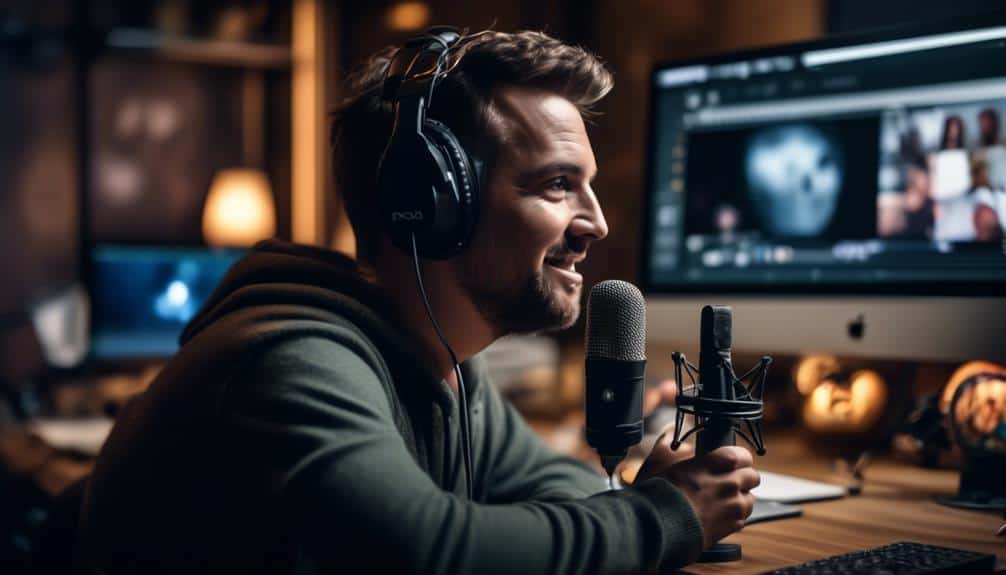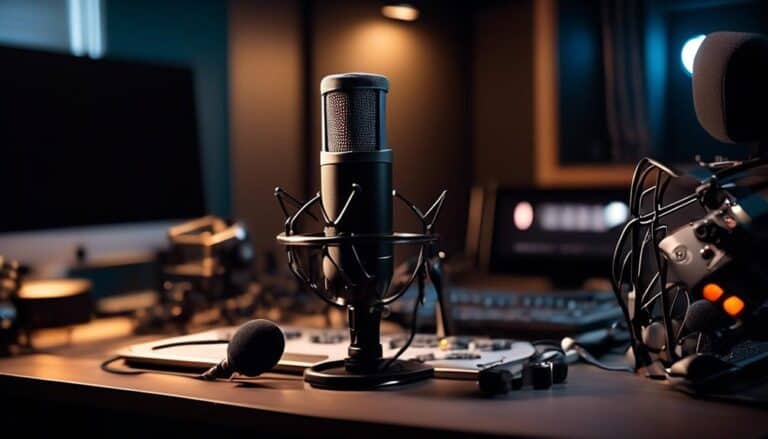The Ultimate Guide to Starting a Podcast for Your Blog
As you ponder the idea of expanding your blog's reach and engaging your audience in a new way, have you ever considered the power of podcasting? The realm of podcasting opens up a world of possibilities for your blog, allowing you to connect with your readers in a more personal and dynamic way.
From understanding the basics to the intricacies of equipment and content planning, embarking on this podcasting journey may just be the missing element your blog needs to truly stand out.
Key Takeaways
- Understanding fundamental podcasting basics is crucial for success.
- Prioritize good audio quality while finding a setup that fits your needs.
- Structure content with engaging intros, informative segments, and clear calls to action.
- Tailor episode length based on the podcast format and topic.
Understanding Podcasting Basics

To begin your podcasting journey successfully, it's crucial to grasp the fundamental basics of podcasting. Understanding these basics won't only help you avoid common mistakes but also allow you to leverage the numerous benefits that podcasting offers. In a world where podcasting trends are on the rise, tapping into this industry growth can significantly enhance your blog's reach and engagement.
One of the key podcasting benefits is the ability to connect with your audience on a more personal level. Unlike written content, podcasts allow your listeners to hear your voice, tone, and passion, creating a stronger bond. However, many podcasters make the mistake of not planning their episodes effectively or neglecting audio quality, which can deter listeners.
Choosing the Right Equipment
How can you ensure high-quality audio for your podcast episodes without breaking the bank? When it comes to choosing the right equipment for your podcast, you have a range of options to consider. For budget-friendly options, you can start with a portable setup that includes essentials like a USB microphone and headphones. These items can provide decent sound quality without requiring a significant investment.
If you're looking to step up your game and invest in high-end equipment, consider setting up a studio with a professional microphone, audio interface, and studio headphones. While this may involve a higher initial cost, it can significantly enhance the audio quality of your podcast and give it a more polished sound.
Ultimately, the choice between budget-friendly options and high-end equipment depends on your podcasting goals and budget. Whether you opt for a portable setup or a studio arrangement, the key is to prioritize good audio quality while finding a setup that fits your needs and resources.
Planning Your Podcast Content

When planning your podcast content, consider structuring it with engaging intros and outros, informative main segments, and clear calls to action.
Engage your audience by incorporating interactive elements like listener Q&A sessions, guest interviews, and storytelling segments.
Keep in mind the ideal episode length based on your topic, aiming for a duration that captures attention without overwhelming listeners.
Content Structure Tips
By carefully mapping out the structure of your podcast episodes, you can ensure a cohesive flow of engaging content that keeps your audience captivated from start to finish. Here are three tips to help you plan your podcast content effectively:
- Content Organization: Create a clear outline or storyboard for each episode, including key points you want to cover and the order in which you'll present them.
- Engagement Techniques: Incorporate interactive elements like Q&A sessions, listener polls, or guest interviews to keep your audience involved and interested.
- Storytelling and Listener Interaction: Weave compelling narratives into your episodes to make your content more relatable and encourage feedback and discussions with your listeners.
Audience Engagement Strategies
To enhance the impact of your podcast content and foster a deeper connection with your audience, consider incorporating various interactive elements and storytelling techniques into your episodes.
Encourage listener feedback by asking thought-provoking questions or creating polls on social media related to your podcast topics. This not only makes your audience feel heard but also keeps them engaged.
Additionally, focus on community building by featuring guest interviews, hosting live Q&A sessions, or organizing virtual meetups for your listeners. Building a sense of community around your podcast fosters loyalty and encourages word-of-mouth promotion.
Episode Length Considerations
Consider carefully structuring your podcast episodes to optimize engagement and retention, ensuring that your content remains captivating and concise for your audience. When determining the ideal episode length, keep in mind the following:
- Episode Format: Tailor the length based on the format of your podcast. Interview-style podcasts may require longer episodes, while informational or storytelling formats might be best kept shorter.
- Listener Retention: Pay attention to listener behavior. Analyze data to see where drop-off rates occur and adjust your episode length accordingly to maintain engagement.
- Experiment: Don't be afraid to experiment with episode lengths. Test different durations and gather feedback from your audience to find the sweet spot that keeps them coming back for more.
Recording and Editing Your Episodes

When preparing to record and edit your podcast episodes, there are several key steps to consider:
- Essential Recording Equipment: Invest in a good quality microphone, headphones, and a pop filter to capture clear and crisp audio.
- Explore Editing Software Options: Research different editing software programs to find one that suits your needs and budget. Popular options include Audacity, Adobe Audition, and GarageBand.
- Implement Sound Quality Tips: Utilize a quiet recording space, adjust microphone settings for optimal sound levels, and consider using music or sound effects to enhance your podcast.
Recording Equipment Needed
Invest in quality recording equipment to ensure that your podcast episodes have professional sound quality and are engaging for your listeners. Here are three essential items to get you started:
- Microphone: A good quality microphone is crucial for clear audio. Consider options like the budget-friendly Blue Yeti or the versatile Audio-Technica ATR2100x-USB.
- Headphones: Invest in a comfortable pair of headphones to monitor audio levels and ensure sound quality. Look for options like the Sony MDR7506 or the budget-friendly Audio-Technica ATH-M20x.
- Audio Interface: This device connects your microphone to your computer and helps improve sound quality. Popular options include the Focusrite Scarlett 2i2 or the budget-friendly Behringer U-Phoria UM2.
With these key items, you'll be well on your way to creating a top-notch podcast recording setup.
Editing Software Options
To enhance the professional quality of your podcast episodes, the next crucial step is to explore various editing software options for recording and refining your content. When choosing editing software, consider tools that offer advanced editing techniques to help you achieve that polished podcast style.
Look for software that supports a collaborative editing process, especially if you work with remote teams. Programs like Adobe Audition, Audacity, or GarageBand are popular choices that provide a range of features to enhance your podcast production. These platforms allow you to cut, splice, add music, adjust audio levels, and apply effects seamlessly.
Sound Quality Tips
Enhance the quality of your podcast episodes by focusing on sound tips during the recording and editing process. Follow these essential sound quality tips to ensure your podcast sounds professional and engaging:
- Microphone Placement: Position your microphone correctly to capture clear and crisp audio. Ensure the mic is close enough to your mouth but not too close to avoid plosives.
- Minimize Background Noise: Find a quiet space to record your episodes to reduce background noise interference. Consider using noise-canceling tools or soundproofing techniques in your recording area.
- Editing for Clarity: During the editing process, remove any unwanted background noise, adjust volume levels, and enhance audio quality to create a polished final product that captivates your audience.
Creating Podcast Cover Art

When designing your podcast cover art, focus on creating a visually appealing and engaging image that accurately represents your podcast's content and style. Your podcast cover art is the first thing potential listeners will see, so make sure it captures their attention and gives them a glimpse of what your podcast is all about. Here are some key elements to consider when creating your podcast cover art:
| Key Element | Description |
|---|---|
| Graphic Design | Use eye-catching visuals, colors, and fonts that resonate with your brand identity. |
| Brand Identity | Ensure that your cover art reflects your brand's personality and connects with your audience. |
| Clear Title | Include a clear and readable title that conveys the essence of your podcast. |
| Consistent Theme | Maintain a consistent theme throughout your cover art to establish recognition. |
Promoting Your Podcast
Boost your podcast's visibility and attract a wider audience by implementing effective promotional strategies across various platforms. To ensure your podcast reaches the right ears, here are three key tactics to promote it successfully:
- Leverage Social Media: Share engaging snippets of your podcast episodes on platforms like Instagram, Twitter, and Facebook. Encourage your followers to like, comment, and share, amplifying your reach organically.
- Email Marketing: Build a strong email list of subscribers who are interested in your podcast content. Send out regular newsletters highlighting new episodes, behind-the-scenes insights, and exclusive offers to keep your audience engaged and coming back for more.
- Collaborate with Influencers: Partner with influencers or other podcasters in your niche to cross-promote your podcasts. Guest appearances, shoutouts, or joint episodes can introduce your podcast to a wider audience and create a buzz around your content.
Engaging With Your Audience

To deepen the connection with your audience and cultivate a loyal following for your podcast, actively engaging with your listeners is crucial. Building a community around your podcast not only enhances the listening experience but also fosters a sense of belonging. Encouraging listener feedback and facilitating community interaction can set your podcast apart and make it more appealing to your audience.
Here is a simple yet effective way to engage with your audience:
| Engagement Strategy | Description | Benefits |
|————————-|—————–|————–|
| Encourage Listener Feedback | Invite your listeners to share their thoughts, ideas, and questions. | – Gain valuable insights
- Strengthen connection with audience
- Improve content based on feedback |
| Foster Community Interaction | Create a platform where listeners can interact with each other, such as a Facebook group or online forum. | – Building a community of like-minded individuals
- Encouraging discussions and collaborations
- Increasing listener retention |
Frequently Asked Questions
How Can I Monetize My Podcast and Make Money From It?
To monetize your podcast and make money from it, consider affiliate marketing, selling merchandise, crowdfunding campaigns, and forming partnerships. These strategies can help you generate revenue while offering value to your audience.
What Are Some Common Mistakes to Avoid When Starting a Podcast for My Blog?
When starting a podcast for your blog, avoid mistakes like poor audio quality, inconsistent posting schedules, neglecting audience engagement, and failing to promote your episodes. These common pitfalls can hinder your podcast's success.
How Can I Attract Sponsors and Advertisers to My Podcast?
To attract sponsors and advertisers to your podcast, focus on growth and engagement. Develop sponsorship strategies by showcasing your audience demographics and engagement rates. Use advertising techniques like dynamic ad insertion to reach a wider audience.
What Are Some Effective Ways to Increase My Podcast's Visibility and Reach a Larger Audience?
To boost your podcast's visibility, focus on social media promotion for wider reach. Optimize SEO to attract more listeners. Collaborate with guests and partner with influencers to expand your audience and attract sponsors.
How Can I Ensure My Podcast Is Legally Compliant With Copyright and Licensing Regulations?
To ensure your podcast is legally compliant, familiarize yourself with fair use guidelines and licensing requirements. Avoid copyright infringement to prevent penalties. Stay informed about regulations to protect your content and reputation.
Conclusion
Now that you have the basics of starting a podcast for your blog, you're ready to dive in and share your unique voice with the world.
Remember to choose the right equipment, plan engaging content, and promote your podcast to reach a wider audience.
Engage with your listeners and watch your podcast grow into a successful extension of your blog.
With dedication and passion, your podcast can become a valuable asset to your online presence.
Happy podcasting!








